RIC-0667 Aboriginal Cult 5-6
Create successful ePaper yourself
Turn your PDF publications into a flip-book with our unique Google optimized e-Paper software.
Indicator:<br />
Forms of Communication<br />
Teachers Notes<br />
Understands that traditional <strong>Aboriginal</strong>s used verbal and nonverbal<br />
forms of communication.<br />
This section will look at how traditional <strong>Aboriginal</strong> people used songs, dances<br />
and stories as an important means of communication. It will explain how traditional<br />
stories were more than just stories, and that songs and dances were also used to<br />
convey meaning.<br />
Songs, dances and stories are an important part of the <strong>Aboriginal</strong> culture. <strong>Aboriginal</strong><br />
people use dance, songs and stories as a means of communication. From a very<br />
young age children are taught about their culture. In some <strong>Aboriginal</strong> groups<br />
today, song ceremonies and dances are still alive, while in other groups not all of<br />
them have been continued.<br />
Songs and dance were often used in ceremonies. It is believed that these songs and<br />
dances came from the Dreaming. Different groups of people and different places<br />
had different songs and dances, which contained important information about<br />
the history of each particular place.<br />
Songs were also used to direct people to certain places, similar to a map. <strong>Aboriginal</strong><br />
people believe that a person who knows many songs is a very intelligent person. In<br />
traditional <strong>Aboriginal</strong> communities, songs are seen as one of the most important<br />
forms of communication.<br />
Traditional songs are used to teach the people about important aspects of their<br />
culture. They can learn about their laws and their history—even food and water<br />
supplies are revealed through song. By singing about the land and its forms,<br />
<strong>Aboriginal</strong> people can direct others to certain places. Through traditional songs<br />
and dances, <strong>Aboriginal</strong> people can learn about morals and values.<br />
The didgeridoo is a musical instrument used by <strong>Aboriginal</strong> people. It has a distinct<br />
note and, when played correctly, makes the sounds of various animals and birds.<br />
Tapping sticks, made from wood, are also used by traditional <strong>Aboriginal</strong> people to<br />
make musical sounds.<br />
Traditional stories are very important to <strong>Aboriginal</strong> people. These stories are handed<br />
down through generations for years and years. Stories are used to teach young<br />
children about how to behave towards others. They also teach them their social<br />
obligations, responsibilities and history of their culture.<br />
<strong>Aboriginal</strong> art is very spiritual. Some art is sacred and is used to express laws and<br />
rites by which traditional <strong>Aboriginal</strong> people live. <strong>Aboriginal</strong> rock art is considered<br />
by many to be the oldest form of art on Earth.<br />
©R.I.C. Publications<br />
Low Resolution Images<br />
Display Copy<br />
• Display a radio, phone, books and other forms of communication in the<br />
class. Explain that they are means by which we can communicate with each<br />
other.<br />
• Give the class an opportunity to use each in role-play situations.<br />
• Tell the students how traditional <strong>Aboriginal</strong> people used paintings, stories,<br />
dances and art to communicate.<br />
• Students need to be made explicitly aware that paper and pencils were not<br />
available to traditional <strong>Aboriginal</strong> people.<br />
• Obtain books from the library that have examples of <strong>Aboriginal</strong> art and<br />
their meanings. (Also refer to the cover of this publication.)<br />
• Worksheets ‘Finish the pattern’, ‘How Many?’, ‘<strong>Aboriginal</strong> Dancing’ and<br />
‘Dot-to-Dot Didgeridoo’ support this lesson.<br />
Finish the Pattern<br />
How Many?<br />
<strong>Aboriginal</strong> Dancing<br />
Dot-to-Dot<br />
Didgeridoo<br />
(pages 62 – 65)<br />
Communication<br />
www.ricgroup.com.au R.I.C. Publications 61Australian <strong>Aboriginal</strong> <strong>Cult</strong>ure 61<br />
ISBN 978-1-86311-807-1


















